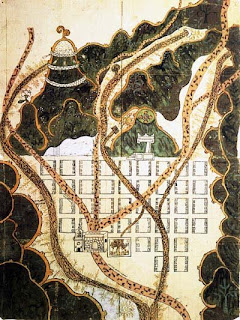
Calixtlahuaca covered the top and most of the slopes of Cerro Tenismo (see photo). There were a number of other terrace hill cities in ancient

The terraced hill cities of the Late Postclassic period are less well known, but this was a major settlement type. Just 15 km south of Calixtlahuaca is Tlacotepec, another Postclassic terraced hill city. It was damaged severely by Frederick Starr by his “excavations” around 1900, and today we know little about the site beyond the several thousand objects that Starr sold to the Field Museum of Natural History (McVicker 1992).
There are a number of representations of terraced hill cities in the codices. One such image from a Cuicatec codex, the Códice Fernéndez Leal (f. 13-14), is shown here (van Doesburg 2001: v.2, f.13-14). There is a battle in progress, with warriors standing on all of the terraces and fending off attackers at the base. Another Oaxacan example (see photo) is from the Relación Geográfica of Texupan (Acuña 1984-88: v.2, p222). The terraced site, on a hill looming above the Spanish colonial town, may have been the Postclassic citey of Texupan.
One final example is provided in the Historia Tolteca-Chichimeca (Kirchhoff, et al. 1976:f. 42v), which is also the scene of a battle. The fact that two out of three codex images show battles suggests that military defense may have been important in the decision to build cities on hills in the Postclassic period. This is the interpretation of Gerardo Gutiérrez, whose 2005 article pointed me toward these images (Gutiérrez 2005).
For Calixtlahuaca, however, the defensive argument has less to support it. It is always difficult to argue from archaeological remains whether features such as city walls were built for defense or for symbolic reasons (there is a big literature on this, I won’t cite sources here). At Calixtlahuaca, two public buildings were built on the flat land at the base of the hill—the royal palace and a ceremonial platform that may have been a ballcourt. If defense were of paramount importance in the design of the site, one would expect that the royal palace would be built on the slopes, or perhaps on top of the cerro.
As far as we can tell from the native historical sources, Calixtlahuaca had no rivals as a political capital early in its history (this is from a paper by Brian Tomaszewski and me that is now in preparation), so perhaps its rulers did not worry about defense in laying out their city. But had they thought more of defense, perhaps they could have held off Axayacatl and the invading Mexica army a bit longer in the 1470s.
I wish someone would write a paper synthesizing what we know about terraced hill cities in Postclassic Mesoamerica.
REFERENCES:
Acuña, René (1984-88) Relaciones geográficas del siglo XVI. 10 vols. Universidad Nacional Autónoma de México, Mexico City.
Feinman, Gary M. and Linda M. Nicholas (2004) Hilltop Terrace Sites of
Feinman, Gary M., Linda M. Nicholas and Helen R. Haines (2002) Houses on a Hill: Classic Period Domestic Life at
Feinman, Gary M., Linda M. Nicholas and Helen R. Haines (2006) Socioeconomic Inequality and the Consumption of Chipped Stone at
Gutiérrez, Gerardo (2005) Jardines defensivos: un acercamiento histórica-arqueológico al use de la vegetación en la guerra antigua. Anales de Antropología 39(1):51-78.
Kirchhoff, Paul, Lina Odena Güemes and Luis Reyes García (editors) (1976) Historia tolteca-chichimeca. Instituto Nacional de Antropología e Historia, Mexico City.
McVicker, Donald (1992) México: La Visión del Cosmos: Three Thousand Years of Creativity. The Mexican Fine Arts Center Museum, Chicago.
van Doesburg, Sebastian (2001) Códices Cuicatecos Porfirio Díaz y Fernández Leal. 2 vols. Grupo Editorial Miguel Angel Porrúa, Mexico City.

